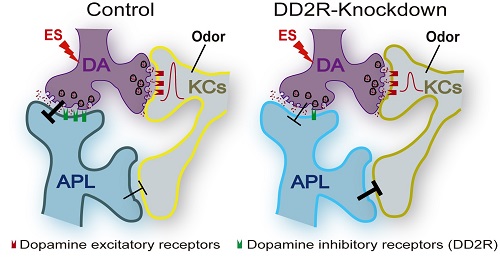Chinese scientists reveal the circuit mechanism of disinhibition in Drosophila olfactory learning
GABAergic neurons are important inhibitory neurons in the central nervous system. In Drosophila brain, a pair of GABAergic neurons form a negative feedback with the learning center neurons, and this recurrent circuit is essential for odor discrimination, which is the base for olfactory learning. However, activating these GABAergic neurons negatively regulates olfactory learning. Thus, precise control of the GABAergic activity is vital for learning and memory.
In neural circuits of learning, dopaminergic (DA) neurons usually present the positive or negative values. In Drosophila aversive olfactory learning, a group of dopaminergic neurons convey the punitive electric shock signal through activating the learning center neurons. In a study published online recently in Proc. Natl. Acad. Sci., a group of Chinese scientists report that the same group of DA neurons form direct synaptic connections with these GABAergic neurons. Utilizing in vivo functional imaging, the researchers demonstrate that these DA neurons suppress the latter through inhibitory DA receptor DD2R, thereby restraining the GABAergic inhibition. This DA-to-GABA regulation releases the restriction on the learning center neurons. More importantly, this regulation is crucial for the eliciting synaptic modification in this circuit. Such modification leads to a change in neural response lasting to post-learning phase, which stands for a memory trace. Behavioral results show that defects in DD2R or its downstream molecules lead to impaired learning and memory. Therefore, this study revealed the neural circuit for precise control of GABAergic neurons and uncovered its important function in synaptic modification during learning and memory formation.
How the brain achieves efficient learning and memory is one of the most intriguing questions for scientific researchers. It’s believed that the neural basis of this function relays on synaptic modification within certain neural circuits. Suppression of inhibitory neurons is known as disinhibition, which has also been found to play important functions in mammalian brains. Findings obtained from this study deepened our understanding of neural architecture and circuit mechanism of disinhibition, which may be conserved for associative learning across species.
This work has been published online in Proc. Natl. Acad. Sci. U.S.A. on Feb 22, 2019, tilted “Suppression of GABAergic neurons through D2-like receptor secures efficient conditioning in Drosophila aversive olfactory learning”. Dr. Mingmin Zhou and Dr. Nannan Chen from Dr. Aike Guo and Dr. Yan Li’s lab at the Institute of Biophysics, Chinese Academy of Sciences are the first authors contributing equally to the work. Dr. Yulong Li’s lab from Peking University provided new recording tools to the study.

Figure: Disinhibition, a neural circuit mechanism for learning and memory
(Imaged by Dr: Li Yan’s group)
Article link: https://www.pnas.org/content/early/2019/02/21/1812342116
Contact: Li Yan, Ph.D.
Principal Investigator
State Key Laboratory of Brain and Cognitive Sciences
Institute of biophysics, Chinese Academy of Sciences
Beijing100101, China
Tel: (86)-10-64881260
Email: liyan@ibp.ac.cn
(Reported by Dr. Li Yan’s group)

